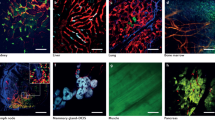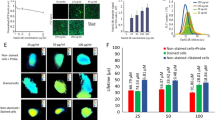Abstract
Optical techniques for functional imaging in mice have a number of key advantages over other common imaging modalities such as magnetic resonance imaging, positron emission tomography or computed tomography, including high resolution, low cost and an extensive library of available contrast agents and reporter genes. A major challenge to such work is the limited penetration depth imposed by tissue turbidity. We describe a window chamber technique by which these limitations can be avoided. This facilitates the study of a wide range of processes, with potential endpoints including longitudinal gene expression, vascular remodeling and angiogenesis, and tumor growth and invasion. We further describe several quantitative imaging and analysis techniques for characterizing in vivo fluorescence properties and functional endpoints, including vascular morphology and oxygenation. The procedure takes ∼2 h to complete, plus up to several weeks for tumor growth and treatment procedures.
This is a preview of subscription content, access via your institution
Access options
Subscribe to this journal
Receive 12 print issues and online access
$259.00 per year
only $21.58 per issue
Buy this article
- Purchase on Springer Link
- Instant access to full article PDF
Prices may be subject to local taxes which are calculated during checkout









Similar content being viewed by others
References
Sandison, J. Observations on growth of blood vessels as seen in transparent chamber introduced into rabbit's ear. Am. J. Anat. 41, 475–496 (1928).
Ide, A. & Warren, S. Vascularization of the Brown Pearce rabbit epithelioma transplant as seen in the transparent ear chamber. Am. J. Roentgenol. 42, 891–889 (1939).
Algire, G. An adaptation of the transparent chamber technique to the mouse. J. Natl. Cancer Inst. 4, 1–11 (1943).
Huang, Q. et al. Noninvasive visualization of tumors in rodent dorsal skin window chambers. Nat. Biotechnol. 17, 1033–1035 (1999).
Jain, R.K., Munn, L.L. & Fukumura, D. Dissecting tumour pathophysiology using intravital microscopy. Nat. Rev. Cancer 2, 266–276 (2002).
Palmer, G.M. & Vishwanath, K. in Handbook of Physics in Medicine and Biology (ed. Robert Splinter) p. 30-31–30-11 (CRC Press/Taylor & Francis Group, 2010).
Vázquez, B.Y., Hightower, C.M., Sapuppo, F., Tartakovsky, D.M. & Intaglietta, M. Functional optical imaging at the microscopic level. J. Biomed. Opt. 15, 011102 doi:10.1117/1.3280270 (2010).
Cao, Y. et al. Observation of incipient tumor angiogenesis that is independent of hypoxia and hypoxia inducible factor-1 activation. Cancer Res. 65, 5498–5505 (2005).
Skala, M., Fontanella, A., Hendargo, H., Dewhirst, M. & Izatt, J. Combined hyperspectral and spectral domain optical coherence tomography microscope for noninvasive hemodynamic imaging. Opt. Lett. 34, 289–291 (2009).
Vakoc, B.J. et al. Three-dimensional microscopy of the tumor microenvironment in vivo using optical frequency domain imaging. Nat. Med. 15, 1219–1223 (2009).
Dreher, M.R. et al. Tumor vascular permeability, accumulation, and penetration of macromolecular drug carriers. J. Natl. Cancer Inst. 98, 335–344 (2006).
Moeller, B.J., Cao, Y., Li, C.Y. & Dewhirst, M.W. Radiation activates HIF-1 to regulate vascular radiosensitivity in tumors: role of reoxygenation, free radicals, and stress granules. Cancer Cell 5, 429–441 (2004).
Zhang, G., Palmer, G., Dewhirst, M. & Fraser, C. A dual-emissive-materials design concept enables tumour hypoxia imaging. Nat. Mater 8, 747–751 (2009).
Sorg, B., Moeller, B., Donovan, O., Cao, Y. & Dewhirst, M. Hyperspectral imaging of hemoglobin saturation in tumor microvasculature and tumor hypoxia development. J. Biomed. Opt. 10, 44004 doi:10.1117/1.2003369 (2005).
Shan, S., Sorg, B. & Dewhirst, M. A novel rodent mammary window of orthotopic breast cancer for intravital microscopy. Microvasc. Res. 65, 109–117 (2003).
Niedre, M. et al. Early photon tomography allows fluorescence detection of lung carcinomas and disease progression in mice in vivo. Proc. Natl. Acad. Sci. USA 105, 19126–19131 (2008).
Sharpe, J. et al. Optical projection tomography as a tool for 3D microscopy and gene expression studies. Science 296, 541–545 (2002).
Yang, G., Pan, F., Parkhurst, C., Grutzendler, J. & Gan, W. Thinned-skull cranial window technique for long-term imaging of the cortex in live mice. Nat. Protoc. 5, 201–208 (2010).
Wang, L.V. & Wu, H.-i. Biomedical Optics: Principles and Imaging (Wiley-Interscience, 2007).
Balas, C. Review of biomedical optical imaging—a powerful, non-invasive, non-ionizing technology for improving in vivo diagnosis. Meas. Sci. Technol. 20 doi:10.1088/0957-0233/20/10/104020 (2009).
Zhang, H., Maslov, K., Stoica, G. & Wang, L. Functional photoacoustic microscopy for high-resolution and noninvasive in vivo imaging. Nat. Biotechnol. 24, 848–851 (2006).
Weissleder, R. Molecular Imaging: Principles and Practice. (People's Medical Pub. House, 2009).
Andersson, C. & Bro, R. The N-way Toolbox for MATLAB. Chemom. Intell. Lab. Syst. 52, 1–4 (2000).
Palmer, G.M. et al. Optical imaging of tumor hypoxia dynamics. J. Biomed. Opt. 15, 066021, doi:10.1117/1.3523363 (2010).
Splinter, R. & Hooper, B.A. An Introduction to Biomedical Optics (Taylor & Francis, 2007).
Jacques, S.L. Skin optics. Oregon Medical Laser Center News, http://omlc.ogi.edu/news/jan98/skinoptics.html (1998).
Acknowledgements
We thank the US Department of Defense Breast Cancer Research Program (Postdoctoral Fellowship W81XWH-07-1-0355 to G.M.P.; Predoctoral Traineeship Award W81XWH-08-BCRP-PREDOC to A.N.F.), the US National Institutes of Health (R01CA40355 to M.W.D.) and the University of Virginia Cancer Center (James and Rebecca Craig Foundation and the NCI Cancer Center Support Grant P30 CA44579 to C.L.F.) for support for this research. We also thank the University of Virginia NanoSTAR Institute for supporting early efforts to develop and test boron nanoparticles as biomedical imaging agents.
Author information
Authors and Affiliations
Contributions
G.M.P and A.N.F. wrote the manuscript, collected the data presented and prepared the figures. S.S. and M.W.D. assisted in the design of the content of the manuscript and revisions. G.H. assisted in the production of figures and revision of the manuscript. C.L.F. and G.Z. assisted in the development of boron nanoparticle techniques and manuscript revision.
Corresponding author
Ethics declarations
Competing interests
C.L.F. has financial interest in Luminesco, Inc., which is commercializing the BNP technology.
Rights and permissions
About this article
Cite this article
Palmer, G., Fontanella, A., Shan, S. et al. In vivo optical molecular imaging and analysis in mice using dorsal window chamber models applied to hypoxia, vasculature and fluorescent reporters. Nat Protoc 6, 1355–1366 (2011). https://doi.org/10.1038/nprot.2011.349
Published:
Issue Date:
DOI: https://doi.org/10.1038/nprot.2011.349
This article is cited by
-
Understanding the process of angiogenesis in regenerating earthworm
In Vitro Cellular & Developmental Biology - Animal (2023)
-
Proof of concept of a multimodal intravital molecular imaging system for tumour transpathology investigation
European Journal of Nuclear Medicine and Molecular Imaging (2022)
-
An adapted dorsal skinfold model used for 4D intravital followed by whole-mount imaging to reveal endothelial cell–pericyte association
Scientific Reports (2021)
-
Quantitative imaging of intracellular nanoparticle exposure enables prediction of nanotherapeutic efficacy
Nature Communications (2021)
-
CaCO3-Assisted Preparation of pH-Responsive Immune-Modulating Nanoparticles for Augmented Chemo-Immunotherapy
Nano-Micro Letters (2021)
Comments
By submitting a comment you agree to abide by our Terms and Community Guidelines. If you find something abusive or that does not comply with our terms or guidelines please flag it as inappropriate.



